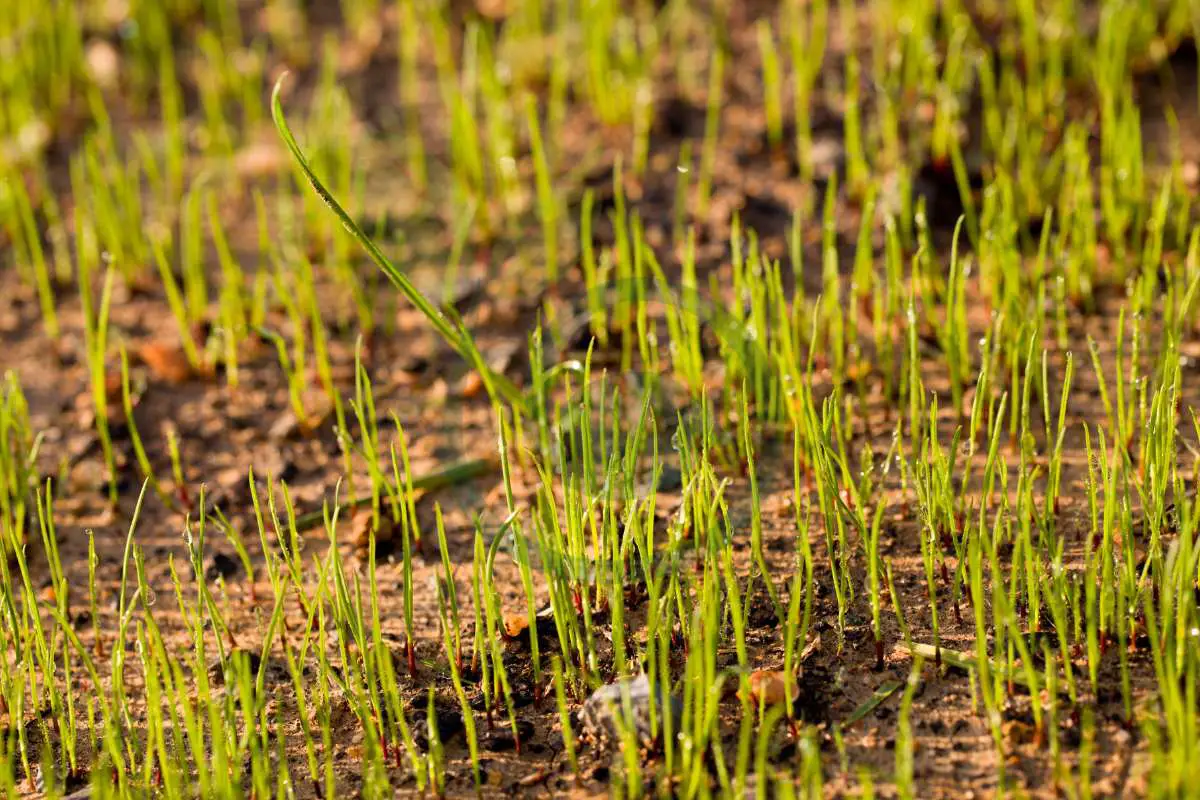Wondering if late fall is too late to plant grass seed? Contrary to popular belief, planting grass seed in late fall can actually be beneficial. While spring is traditionally seen as the ideal time for seeding, late fall offers cooler temperatures and consistent moisture that can promote successful germination and root development. By planting in late fall, your grass seeds have the opportunity to establish strong roots before winter dormancy sets in, giving them a head start for lush growth come spring. Stay tuned to discover the timing, dos and don'ts of planting grass seed on a cool surface in late fall for a vibrant lawn next season.
Key Takeaways
- Late fall seeding can benefit from cooler temperatures and more consistent moisture levels, promoting better grass seed germination and establishment.
- When considering late fall seeding, take into account factors like the type of grass seed, local climate conditions, and the time needed for proper seed establishment before winter.
- Choose grass seed varieties that are suitable for late fall planting, such as cool-season grasses like fescue, ryegrass, or bluegrass, which thrive in lower temperatures.
- Proper soil preparation before seeding is crucial for success, including tasks like soil testing, weed removal, and ensuring good seed-to-soil contact.
- Implement effective seeding techniques like overseeding existing lawns or using a slit seeder to ensure even distribution and optimal seed-to-soil contact.
- After seeding, maintain consistent moisture levels by watering lightly but frequently to keep the soil moist without causing runoff or waterlogging.
- Engage in post-seeding maintenance practices like mowing at the correct height, avoiding heavy foot traffic, and monitoring for signs of germination and growth.
- Anticipate spring expectations such as the need for continued watering, fertilization, and monitoring for weed growth to support the newly established grass.
- Overcome challenges by addressing issues like bird feeding on seeds, frost heaving, or inconsistent moisture levels through protective measures and proactive lawn care practices.
Benefits of Late Fall Seeding
Cooler Temperatures
Cooler temperatures in late fall promote grass seed dormancy, which is crucial for successful germination of season grasses. This dormancy helps seeds withstand harsh winter conditions.
Reduced water evaporation during this time ensures that the soil remains moist, providing optimal conditions for seed germination. With less heat, water retention is higher.
Late fall seeding in cool areas also has the advantage of slowing down weed growth, giving newly planted grass seeds a competitive edge to establish themselves.
Better Germination
Late fall seeding guarantees consistent moisture levels crucial for successful germination. The cooler weather prevents rapid drying out of the soil, ensuring adequate hydration for seeds.
Ensuring proper seed-to-soil contact is essential for germination success. Late fall's cool temperatures facilitate this by allowing the soil to remain moist longer, promoting strong root development.
The favorable conditions in late fall also help in facilitating root development, leading to healthier and more robust grass growth when spring arrives.
Early Establishment
Seeding in late fall allows roots to establish before winter sets in, giving them a head start for spring growth. Strong root systems developed during this period are better equipped to withstand winter stresses.
This early establishment phase not only strengthens the grass but also improves overall lawn health by creating a solid foundation for future growth. Grass seeded in late fall tends to have a thicker turf come springtime.
Considerations for Late Fall Seeding
Climate Impact
When considering late fall seeding in cool regions, it's crucial to analyze regional weather patterns. Understanding the climate helps in adapting planting strategies effectively. Make sure to optimize grass seed selection based on the specific environmental conditions.
Frost Dates
To ensure successful late fall seeding, start by determining your area's local frost dates. Avoid planting during freezing conditions as it can hinder seed germination. Plan your seeding schedule accordingly to avoid any detrimental effects.
Soil Temperature
Check the soil temperature before planting grass seeds in late fall to ensure their viability. Understand the optimal range required for successful germination and adjust your planting time accordingly based on soil warmth.
Selecting Suitable Grass Seed

Climate-Based Choices
When selecting grass seed for late fall planting, it's crucial to consider the local climate. Look at the temperature and precipitation levels in your area. Opt for resilient varieties that can withstand the conditions of late fall.
Shade vs Sun
Assess the amount of sunlight your planting area receives to determine whether it is in shade or sun. Match grass types accordingly based on their shade or sun requirements. Ensure that the seeds have proper growth conditions to thrive.
Recommended Types
Identify cold-tolerant grass species, such as fescue and ryegrass, which are suitable for late fall planting due to their hardiness. Choose varieties with quick germination rates, ensuring new grass seedlings establish themselves before winter sets in. Opt for grasses known to be particularly suited for planting later in the season.
Soil Preparation Steps

Testing Soil
Conduct soil tests to check pH levels and nutrient content. Understand the drainage capacity of your soil. Prepare the soil to create an environment conducive for seed growth.
Enhancing Nutrients
Apply suitable fertilizers to promote soil health. Increase nutrient levels to support robust seedling development. Ensure a well-rounded nutrition profile in the soil for optimal growth.
Leveling Ground
Smooth out any uneven surfaces on the ground to promote uniform grass growth. Prevent water from pooling after planting seeds. Enhance seed coverage across the entire area for consistent results.
Seeding Techniques
Choosing Methods
When planting grass seed in late fall, select between broadcasting or precision seeding techniques based on your lawn size. For larger areas, consider hydroseeding for efficient coverage. Match the seeding method to your lawn's specific needs.
Ensuring Seed Contact
To promote germination, ensure optimal seed-soil contact by raking the soil gently after spreading the seeds. Prevent seed washout by lightly watering and covering with a thin layer of mulch. Protect seeds from birds by using bird netting or scare tactics.
Coverage Uniformity
For healthy growth, strive for consistent seed distribution across the entire lawn area. Avoid over-seeding in certain spots to prevent overcrowding and competition among young grass plants. Ensure even coverage to promote uniform growth and lush greenery.
Watering After Seeding
Initial Watering
After planting grass seeds in late fall, provide sufficient moisture to support germination. Avoid overwatering to prevent soil waterlogging, which can hinder seed growth. Proper watering is crucial for the initial stages of seed development.
Maintenance Schedule
Establish a post-planting care routine to ensure the seeds thrive during late fall. Regularly monitor the progress of seedlings to identify any issues early on. Adjust maintenance tasks such as watering and fertilization based on the growth stage of the grass.
Post-Seeding Maintenance
Fertilization Timing
After planting grass seed in late fall, it's crucial to fertilize at the right growth stages. Apply fertilizers during key development phases to support healthy grass growth. Avoid overdoing it with young seedlings as this can harm rather than benefit them. Proper fertilization promotes robust and lush grass development.
Weed Control
To ensure your newly planted grass thrives, focus on effective weed control strategies. Implement measures to prevent weeds from taking over your lawn post-planting. If necessary, use herbicides sparingly and with caution after seeding to avoid damaging the delicate new grass. Maintaining a weed-free environment is essential for optimal grass growth.
Mowing Tips
Once your late fall-planted grass reaches the recommended height, it's time to start mowing. Use sharp mower blades for clean cuts that won't stress or damage the grass blades. Following proper mowing techniques is vital for overall lawn health and appearance.
Spring Expectations
Germination Success
Planting grass seed in late fall sets the stage for germination success come spring. Monitor seedling emergence rates closely to track progress and identify any issues early on. Address any germination problems promptly to ensure optimal growth conditions are maintained.
Proper care during the fall planting season will pay off when the warmer weather arrives. By monitoring the emergence rates of the newly planted seeds, you can gauge their viability and adjust your maintenance practices accordingly. Addressing any germination issues promptly is crucial to prevent setbacks that could hinder successful growth in the spring.
To achieve maximum germination success, it's essential to provide optimal conditions for the grass seeds. This includes ensuring adequate moisture levels, proper sunlight exposure, and suitable soil temperatures. By creating an environment conducive to growth, you can set your lawn up for lush greenery in the upcoming season.
Lawn Thickness
When planting grass seed in late fall, aim for uniform thickness across your lawn for a visually appealing result. A uniformly thick lawn not only looks aesthetically pleasing but also helps prevent weed infestations by crowding out unwanted plants. Promoting a dense turf through proper seeding techniques is key to achieving this goal.
Dense turf not only enhances the visual appeal of your lawn but also contributes to its overall health and resilience. By promoting thick grass coverage, you create a natural barrier against weed encroachment and promote a healthier ecosystem within your yard. Achieving a lush lawn appearance through proper seeding practices will elevate the beauty of your outdoor space.
Overcoming Challenges
Pest Management
Identifying common lawn pests in late fall is crucial for successful grass seed planting. Recognizing pests like grubs, armyworms, and chinch bugs can help prevent damage to new seedlings. Implementing pest control measures when necessary can protect the grass seed from potential harm.
To safeguard the growth of grass seedlings, it's essential to take proactive steps against pests. Regularly inspecting the lawn for signs of infestation and addressing them promptly can prevent extensive damage. Applying organic or chemical treatments selectively can aid in controlling pest populations effectively.
Protecting grass seedlings from pest damage involves creating a healthy environment that discourages infestations. Maintaining proper watering schedules and avoiding over-fertilization can promote strong root growth, making plants more resistant to pests' attacks.
Disease Prevention
Preventing fungal diseases is vital during the late fall planting season. Ensuring adequate air circulation around the newly planted seeds can reduce moisture levels, minimizing the risk of fungal infections. Monitoring the lawn's health regularly allows for early detection of disease signs such as discoloration or wilting.
Applying fungicides preventatively may be necessary in areas prone to fungal diseases. Choosing appropriate products based on specific disease risks and following application instructions diligently are key steps in disease prevention strategies.
Closing Thoughts
In conclusion, late fall seeding can be a game-changer for your lawn. By understanding the benefits, considerations, and necessary steps, you are equipped to tackle this task successfully. Selecting the right grass seed, preparing the soil diligently, and following proper seeding techniques are pivotal for a lush spring lawn. Remember to maintain consistent watering post-seeding and stay proactive in addressing challenges that may arise. Anticipate a vibrant and healthy lawn come spring by investing effort now.
Take charge of your lawn's health by implementing these late fall seeding strategies. Your dedication today will yield a beautiful and resilient lawn tomorrow. Stay informed, stay committed, and watch your outdoor space transform into a green oasis. Your lawn will thank you!
Frequently Asked Questions
Can grass seed be planted in late fall?
Yes, you can plant grass seed in late fall. Late fall seeding takes advantage of cooler temperatures and increased moisture levels, promoting optimal conditions for seed germination and establishment.
What are the benefits of late fall seeding?
Late fall seeding allows the grass to establish roots before winter dormancy, resulting in earlier spring green-up. It also reduces competition from weeds and provides a head start for your lawn's growth in the following spring.
How do I select suitable grass seed for late fall planting?
Choose cool-season grass varieties like Kentucky bluegrass or fescue that thrive in colder temperatures. Opt for high-quality seeds suited to your specific climate and soil conditions for successful germination and long-term lawn health.
What are some key considerations for late fall seeding?
Ensure proper soil preparation by removing debris, loosening compacted soil, and addressing any pH imbalances. Monitor weather conditions to avoid extreme cold or frost that could hinder seed growth. Adequate watering after seeding is crucial for successful establishment.
How often should I water after planting grass seed in late fall?
Water newly seeded areas lightly but frequently to keep the topsoil consistently moist without causing puddles or runoff. Aim to provide around 1 inch of water per week through light daily watering sessions unless there is sufficient rainfall during this period.
Image Source: Paid image from CANVA


